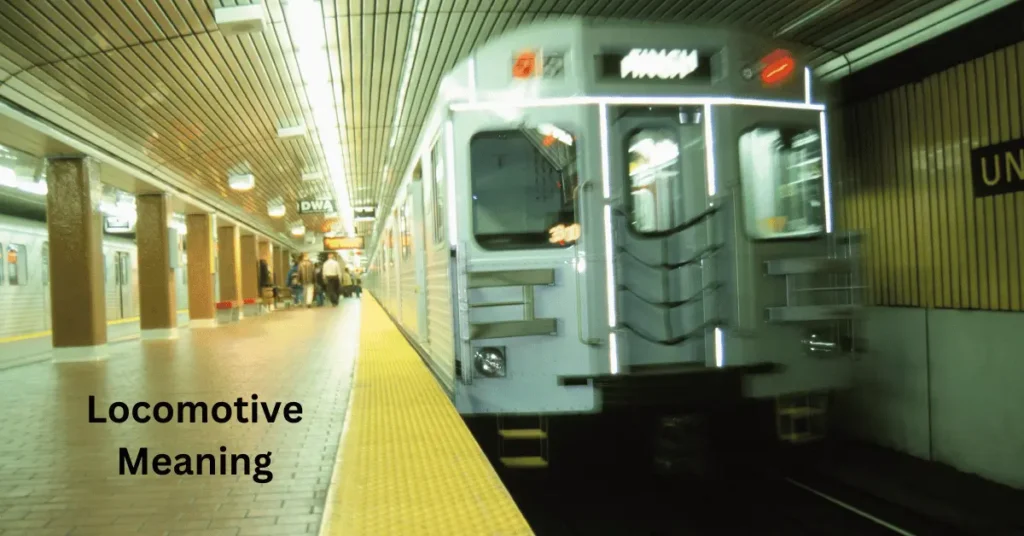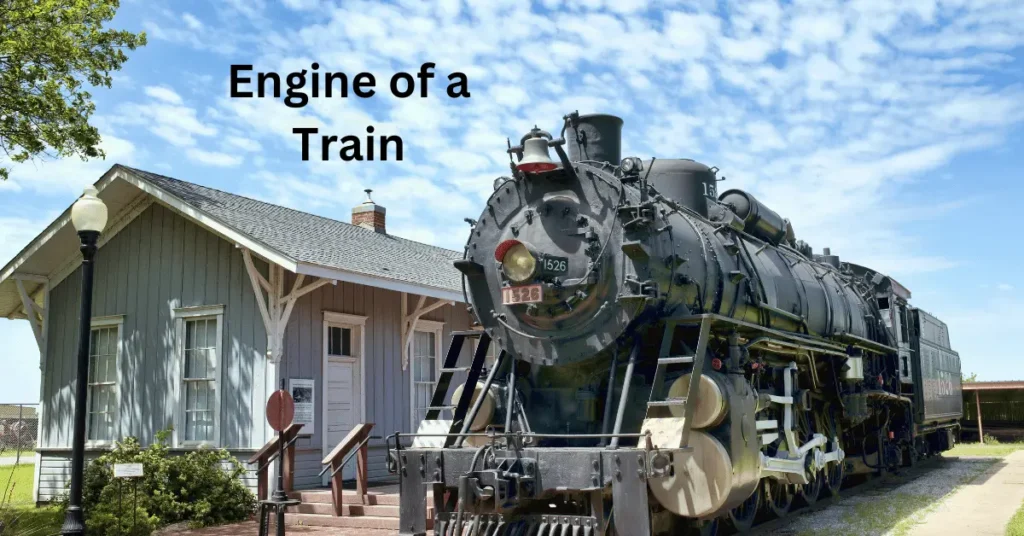Locomotive Meaning

Have you ever wondered what the term “locomotive meaning” really refers to? If you’ve ever seen a train, you’re probably familiar with the massive engine at the front that pulls the entire train along the tracks.
That powerful machine is called a locomotive! In simple terms, a locomotive is the engine of a train, responsible for giving it the power to move.
In this article, we’ll dive deeper into what locomotive meaning is, its history, and how it has evolved over time.
Whether you’re a train enthusiast or just curious, you’ll find this information interesting and easy to understand!
What Does Locomotive Mean?
When we talk about a locomotive, we are referring to the engine of a train, the powerhouse that drives the entire train forward.
Essentially, it’s the vehicle responsible for pulling or pushing the train along the tracks, using its engine to generate the necessary power.
The word “locomotive” comes from two Latin words: “locus”, meaning “place,” and “motivus”, meaning “moving” or “causing motion.”
So, a locomotive is literally something that causes motion or movement, and in the context of trains, it refers to the engine that moves the train.
Locomotives are designed to provide the necessary force to overcome friction, gravity, and other factors that could slow down the train, especially when carrying heavy cargo or passengers.
They are usually found at the front of the train, but in some cases, locomotives can be positioned at the rear or even in multiple locations within a train, depending on the design and specific needs of the route.
Modern locomotives can be powered by various sources, including steam (historically), diesel, or electricity.
Steam locomotives were the first to revolutionize rail transportation in the 19th century, but today, diesel-electric locomotives are the most common.
These engines can range from small, compact units for light freight or passenger services, to massive, powerful machines designed for hauling large quantities of goods over long distances.
In summary, a locomotive is the engine of a train, responsible for pulling or pushing it along the tracks by generating the necessary force to move.
Whether powered by steam, diesel, or electricity, locomotives are essential for train operations worldwide.
Definition and Examples of Locomotive Meaning
A locomotive is a type of railway vehicle that provides the motive power for a train. It is typically equipped with a powerful engine designed to pull or push train cars, transporting passengers or freight across long distances.
The primary function of a locomotive is to generate enough force to move the entire train along the tracks, overcoming resistance like friction and gravity.
Definition:
In simple terms, a locomotive is the engine of a train. It is the key component that gives the train its ability to move, usually positioned at the front of the train, though in some cases, it may be located at the rear or distributed across multiple points within the train.
Locomotives can be powered by different sources, including steam, diesel, or electricity, depending on the type and purpose of the train.
Examples of Locomotive Meaning
Steam Locomotive
In the 19th and early 20th centuries, steam-powered locomotives were the first to revolutionize the railway industry.
These locomotives used steam from boiling water to power a piston engine, which then moved the train. An iconic example is the “Flying Scotsman”, a famous British steam locomotive that still operates today for special occasions.
Example: The steam locomotive “Thomas” in the children’s TV show Thomas & Friends is a classic example of a train engine that has captured the imagination of millions.
Diesel Locomotive
Diesel locomotives are more common today and use a diesel engine to generate power. They are much more efficient and versatile than steam engines, as they can operate without the need for a constant supply of water or coal.
A notable example is the GE AC6000CW, a powerful diesel-electric locomotive widely used in North America.
Example: Many freight trains in the U.S. are powered by diesel locomotives, such as those operated by Union Pacific or BNSF Railway.
Electric Locomotive
Electric locomotives are powered by electricity, often supplied via overhead wires or tracks. These locomotives are used in areas where the railway infrastructure supports electric power, such as urban transit systems or high-speed rail networks.
An example is the Shinkansen in Japan, which is an electric-powered high-speed train.
Example: The Eurostar trains, which connect the UK with mainland Europe, are electric locomotives that offer fast, efficient travel through the Channel Tunnel.
Hybrid Locomotive
Hybrid locomotives combine both diesel and electric power, allowing for greater efficiency and flexibility. These locomotives can switch between diesel and electric power based on the availability of electricity along the tracks.
Example: The EMD SD70ACe-H is a hybrid diesel-electric locomotive used by freight carriers like CSX Transportation to operate in areas with both electrified and non-electrified tracks.
To summarize, a locomotive is the engine of a train, and it can come in several forms—steam, diesel, electric, or hybrid—depending on the technology and purpose of the train.
Whether it’s the classic steam locomotive or the modern electric-powered train, the locomotive is a crucial element in rail transportation, providing the power to move the train along the tracks.
Word Origin of Locomotive

The word “locomotive” has its roots in Latin, derived from two key elements: “locus” and “motivus.”
- Locus – The Latin word “locus” means “place” or “location.” It refers to a specific point or position. In the case of the locomotive, this part of the word emphasizes the idea of movement from one place to another.
- Motivus – The Latin word “motivus” comes from the verb “movere,” meaning “to move.” Motivus refers to something that causes movement, or the force behind motion.
When combined, the term “locomotive” essentially means “moving from place to place,” or more specifically, “the engine that causes movement.”
Evolution of the Term
The term “locomotive” was first used in the early 19th century, during the time when the steam engine was being developed for use in rail transportation.
Before the widespread use of railways, the word “locomotive” had been used in other contexts, but it became more closely associated with the powerful steam engines that revolutionized transportation.
The first “locomotive” to be commonly known by this name was “The Locomotion No. 1”, designed by the famous engineer George Stephenson in 1825.
It was the engine of the first public railway in the world, the Stockton and Darlington Railway in England. As trains began to grow in popularity, the term “locomotive” became firmly associated with the steam engines that powered these trains.
Further Development
As railroads spread across the globe, the word “locomotive” evolved to encompass not just steam engines, but also the diesel and electric-powered engines that succeeded them. Today, the term is used for any engine that powers a train, regardless of the fuel source.
Thus, the word “locomotive” ties together both its Latin origin meaning — “the engine that moves from place to place” — and its practical function in railway transportation. It’s a fitting name for the powerful machines that have been central to the development of the railway system and continue to be integral to global transportation today.
FAQs
What is the meaning of the word “locomotive”?
The word “locomotive” refers to the engine of a train that provides the power to move it. It is responsible for pulling or pushing the train along the tracks. The term comes from Latin, where “locus” means “place” and “motivus” means “moving,” so a locomotive is essentially something that causes movement from one place to another.
What are the different types of locomotives?
There are several types of locomotives, including:
Steam locomotives: Powered by steam generated from boiling water.
Diesel locomotives: Powered by diesel engines.
Electric locomotives: Powered by electricity from overhead wires or tracks.
Hybrid locomotives: Combine both diesel and electric power sources for greater flexibility and efficiency.
Who invented the locomotive?
The first practical locomotive was invented by George Stephenson, an English engineer, in the early 19th century. His locomotive, called “Locomotion No. 1,” began running on the Stockton and Darlington Railway in England in 1825. This marked the beginning of widespread rail transport powered by locomotives.
Why is the locomotive called the “engine” of a train?
The locomotive is often called the “engine” of a train because it is the primary source of power for the train. It provides the necessary force to move the train by pulling or pushing the connected cars, whether they are carrying passengers or freight. The term “engine” is used because the locomotive functions like the engine in a car, powering the movement.
How does a locomotive move a train?
A locomotive moves a train by generating power, typically through its engine, to overcome resistance. In steam locomotives, steam pressure powers pistons that move the train. Diesel locomotives use a diesel engine to generate electricity, which powers traction motors that turn the wheels. Electric locomotives rely on electrical power from overhead wires or tracks to power their motors. In all cases, the locomotive’s engine provides the necessary force to move the train forward.
Conclusion
In simple terms, a locomotive is the powerful engine that moves a train. It plays a crucial role in transportation, whether it’s a steam, diesel, or electric locomotive.
From the early steam engines to today’s modern machines, locomotives have evolved but still serve the same purpose: to provide the power needed to move trains across vast distances.
Understanding the meaning and history of the locomotive helps us appreciate the importance of these machines in shaping the world of rail travel.
Extra Points on Locomotives
- Locomotives Aren’t Just for Trains: While most people associate locomotives with trains, some types are also used for other purposes. For example, shunting locomotives are smaller engines used to move trains around in railway yards and stations.
- The Evolution of Power: The first locomotives were powered by steam, but today, we have diesel and electric locomotives that are much more efficient and environmentally friendly. Some modern locomotives even use hybrid technology, which combines diesel and electric power.
- High-Speed Locomotives: Some locomotives are designed to reach incredible speeds. High-speed trains like Japan’s Shinkansen or France’s TGV are powered by electric locomotives and can travel over 200 miles per hour, making long-distance travel much faster.
- Locomotive Design: Locomotives come in many shapes and sizes. Some are made to carry heavy freight, while others are designed for speed and passenger comfort. They are built with powerful engines, robust frames, and modern technology to ensure safety and efficiency.
- Global Use: Locomotives are used all over the world. Whether in the United States, Europe, Asia, or Australia, trains powered by locomotives are vital for transporting goods and passengers across countries and continents.